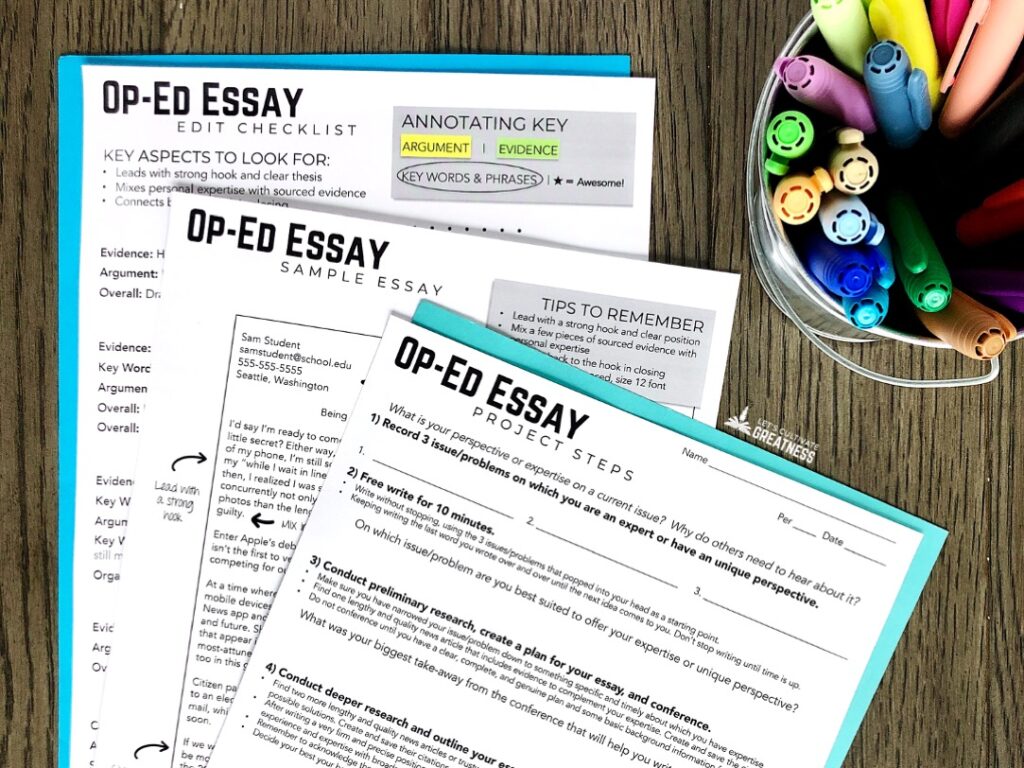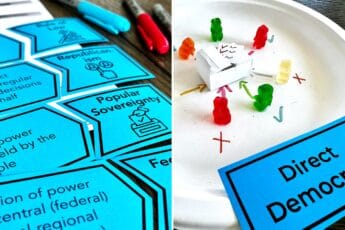It really can be argued that Government and Civics is one of the most essential classes students can take during their K-12 experience.
That’s because a huge reason behind our modern public school system in the first place, thanks to John Dewey, was to create citizens who were equipped to participate in the American democratic society.
This core value isn’t anything radical for a social studies teacher. It’s what gets us out of bed in the morning—to make the next great generation of citizens.
But in reality, all the “what” of endless required standards often get in the way of that “why,” especially when your Civics class is only one semester!
It is tough to cover all three branches, plus everything else, and still have time for civic engagement projects.
But I’ve made it an important guiding principle to include authentic civic service projects, even small ones. And I think that’s exactly where a boring civics class is transformed into one your students remember the most.
Here are five simple things you can do to incorporate authentic political engagement. Each idea comes with two options: super easy and still pretty easy!
These activities are the moments I look forward to each semester, which is why I’ve also made them into a political service project component of my class.
1. Incorporate in Op-Ed Essays
Super easy: When pulling sources for your units, seek editorials from columnists and community members. Have students analyze these argumentative sources alongside the newspaper and textbook sources you already use. Just search “op-ed” or “opinion” along with any subject, and you will find all sorts of rich material to use. Or pull up the editorial section online when particularly juicy ones are published.
Still pretty easy: Challenge your students to write their own op-ed essay for one of your units. Teenagers on the verge of voting and heirs of the current political environment are well-positioned to have a strong personal voice that newspaper editors love.

Any topic you touch on is perfect for adding one in. And my everything’s-included Op-Ed kit makes this a breeze.
For example, do your students have to pass a state-mandated U.S. Citizenship test? Spend a couple of days researching, discussing, and reflecting on this relatively recent requirement that many states now have. Your students are the perfect experts to weigh in on this mandate’s value (or lack thereof!).
My state doesn’t have this requirement, but I make it one in my class, so it adds an interesting spin on if it should be. I have the 4-part test series I use with an accompanying op-ed writing project in my shop.
2. Attend a School Board Meeting
Super easy: If you’ve never attended one before, go so you can describe first-hand how democracy works!
School boards have strict public record laws to follow, so it’s an easy way to illustrate democracy tangibly to your students. Show students where the agenda, minutes, and documents are housed online and how to read them. Point out how a portion of the meeting is dedicated to public comment and how each member has been elected to represent an area of the district.
Your students’ school board is a microsystem of democracy, making it perfect to use as examples for all concepts throughout the class.
Still pretty easy: Find a way to require or strongly encourage students to attend at least one themselves. Challenge them to give a speech during the public comment segment on something they are passionate about. Ask students to share their experiences the next day in class.
3. Write a Thank You Letter
Super easy: Take 20 minutes and write a quick note to someone in the news you admire for standing up for what they believe in.
Not someone you know personally who did something in your little world but someone you admire from afar. The tragic victim who fought and got a new state law created last year. The person who founded an impactful non-profit program that recently caught the attention of the local news networks. The citizen advocate who had their own passionate op-ed published in today’s paper.
You’d be surprised how easy it is to find a viable mailing or email address with a bit of Googling.
Share the letter with your students before mailing it. Be a role model of sharing gratitude and admiration and set an example that acts like this is normal.

Still pretty easy: Have students write their own from-afar thank you notes. This makes the perfect lesson for emergency sub plans, a shortened class thanks to the assembly schedule, or a day-before-holiday-break project.
I keep a bulk box of colorful blank note cards handy for occasions like this. Grab my universal thank you letter writing kit to have on hand too.
4. Follow Your Elected Officials
Super easy: Find and follow the official accounts of local, state, and federal officers representing you and your students. And share with students that you follow them! Normalize it.
You’ll be up-to-date on all their latest actions and any public events they’re hosting so you can share them with your students.
Still pretty easy: Allocate 10 minutes of class time one day to have your students do the same on whichever platforms they are on. It likely doesn’t occur to your students that government officials are on TikTok and Instagram like their favorite influencers.
If an official doesn’t have an account or doesn’t seem very active on it, turn that into a teachable moment by asking your students how that influences their opinions of them.
5. Call Elected Officials’ Offices
Super easy: Contact your state legislative representatives and U.S. Congress members’ offices. Chat with their legislative aids. Let them know who you are and ask how best you and your students can form a connection with their offices.
I stayed after once at a town hall meeting for my own Congressional Representative and chatted with her legislative aid. She said she’d connect me with the aids for the Representative that serves my school’s students. There was a follow-up email and contact info was exchanged, but that was about it.
A few months later, though, I got an out-of-the-blue email from their office asking if my students’ Representative could come in and do a Q&A session with them! We essentially got our own town hall meeting and a front-page spread in the local paper. Talk about real-life civic engagement!
Still pretty easy: Once or twice in your course, plan for a moment when a question is raised that is truly only best answered by an elected official’s office, not Google. Then ask one of your students to volunteer to call and ask the question right there in the middle of class. Your wide-eyed students likely won’t think you are serious, but let them know you entirely mean it.
In my three branches unit, we spend a day researching and discussing the practice of Congressional town hall meetings and how fewer and fewer members of Congress are holding them these days. Towards the end of the lesson, I’ve intentionally guided them to wonder, “How many town hall or public events meetings have our members of Congress held this year?”
“Well,” I say, “Let’s ask them.”
So smack in the middle of class, I ask if three students are willing to call our U.S. Representative and two Senators and ask.
I provide them with this basic script:
“Hi, my name is… and I am a student at… located in… A question came up in my Civics class about Representative/Senator So-n-So, and I am wondering if I can put you on speaker phone so we can all hear the answer?”
The biggest barrier to not thinking government is a real thing is never experiencing it as a real thing. These 20 minutes are the best 20 minutes of the whole semester. My students’ minds are blown.
Plus, based on the answers provided by those aids, your students now have genuine, first-hand opinions of their elected officials.
One year, we had one office needing to get back to us, one whose voicemail was full, and one who knew the exact number without hesitation. That made a significant impression on my students.
More civics engagement projects ideas
If these informal activities sound great and you want even more ways to add political action projects into your Government or Civics class, check out my Civics Engagement Service Project kit.

Whether your school has a community or political service requirement or you want to make civic engagement a priority, you need this project kit.
Simply copy a game board for each student and assign them activities to complete! It can be anything from a 5-in-a-row BINGO, to a pick-any-10, to a total blackout.
This kit has everything for students to successfully complete all the actions, including writing kits for op-ed essays and letters to elected officials.
In my classroom, I keep a crate with these how-to guides for students to grab whenever they need them. It’s entirely student-guided. I only have to remind them of the deadline!
Something I once thought was prohibitively time-consuming is now a core component of my class; it requires no more than a 15-minute overview at the beginning of the semester and has given me more warm and fuzzies as a teacher than anything else I have done. I hope it will do the same for you!
I hope these doable ideas help you bring real-life political involvement into your civics classroom!
Feature image photo credit: Josh Johnson









